How to Chalk Paint Furniture | Step by Step For Beginners
Let’s go through the very basics of how to chalk paint furniture and how to topcoat chalk paint with wax. If you already know the basics, stick around, because after that, we’re going to dive into some of the things you might want to do to make your chalk painted furniture even better.
Get more tips and chalk paint secrets that you need to know here!

Here is the dresser we’re going to chalk paint today. When you get up close to it, it might look similar to your furniture. Beaten up, damaged a little bit…
But that’s okay. We’re going to paint this dresser and give it a new life!
Supplies Used to Learn How to Chalk Paint Furniture
As an Amazon Associate, I earn from qualifying purchases. I also may earn from other qualifying purchases with other companies or get free product to review and use. All opinions are my own.
- Krud Kutter
- Chalk Paint
- Paint Brush – This one is becoming my fav
- Wax
- Wax Brush
- Kwikwood
- 220 Grit Sandpaper
- Clear Shellac OR BIN Shellac Primer
Remove Hardware and Clean Dresser
First up, we removed the hardware. Knobs and pulls are usually held on with screws from the inside of the drawers, so we just need to loosen those screws to remove the hardware.
Learn more about how to change hardware on a dresser here.
Then, we need to clean our furniture with some sort of degreasing cleaner and a wet rag. I personally use Krud Kutter, but you can use dish soap mixed in warm soapy water, or TSP.
We want to remove everything that will make our paint not stick.
I personally like to rinse the surface with a clean wet rag after I clean it with a cleaner, just to make sure that the cleaner isn’t leaving a residue that will repel the paint as well. Then we let it dry completely.
Read this post to learn more about how to clean furniture before painting.
Make Repairs / Fill Hardware Holes (Optional)
If your furniture is anything like mine, it probably has scratches, dings, and even broken corners and chipped-up wood. If things like this don’t bother you, you can totally skip past this step.
But, if you want to fix them, I have a really quick and easy trick for you. You can use this stuff called Kwikwood to fill in and fix the damage that’s bigger than a scratch.
Check out the best wood fillers for furniture here.

It feels kind of like clay, so you can shape it easily. It also is the best way to fill holes when replacing furniture hardware.
For this piece, I wanted to change the drawer pulls to knobs, so I just filled in one hole from each of the hardware.
Kwikwood dries in an hour, so you can sand it down flush and get on your way with the rest of the project pretty quickly. Learn more about how to use KwikWood here.
After I’m done painting, I can easily replace that hardware with new knobs now.
Paint With Chalk Paint
Now for the paint! Chalk paint doesn’t require you to sand or prime before you paint. That’s true, but not for every single piece of furniture.
Learn more here about painting furniture without sanding or priming. Or check out the best paints for furniture without sanding here.
I’ll talk more about that later and how you can know if it will work for your piece.
I used Country Chic Paint’s chalk paint, which has excellent adhesion, just like Annie Sloan’s chalk paint. Check out my list of the top chalk paint brands for your future furniture makeovers.
Check out my honest and detailed Country Chic Paint Review here.
I ended up mixing a few different colors of paint to create this color.
Peacoat, Paint the Town, and Mustard. It was maybe a cup of Peacoat, with a Tablespoon of Paint the Town and a quarter cup of mustard. Somewhere around there. haha

I love Country Chic Paint’s colors! It’s also a No VOC, water-based paint that has great coverage.
What kind of brush do you use with chalk paint?
And then I painted it on, using Country Chic Paint’s oval paint brush.
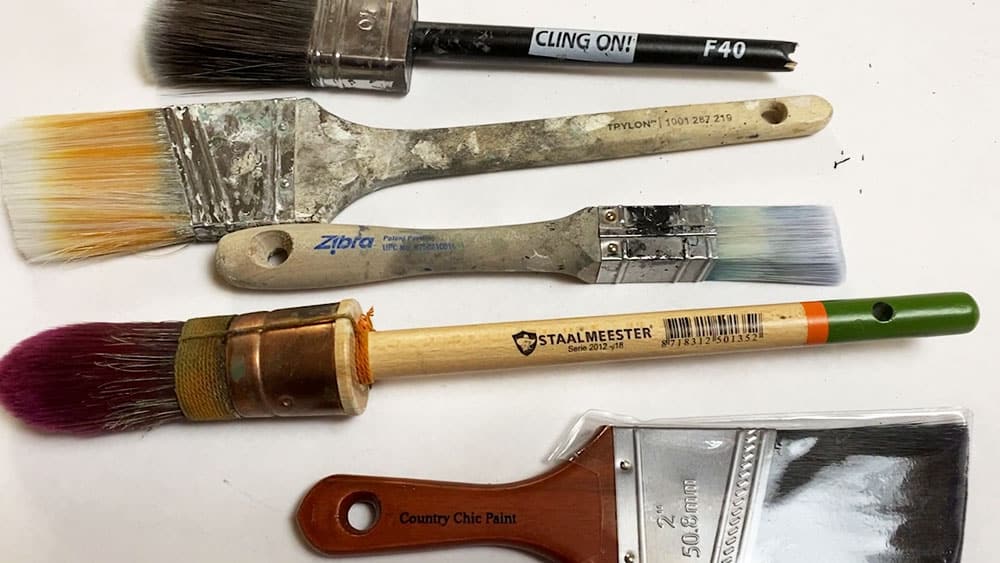
You can use whatever paintbrush you want.
When I started painting furniture, I honestly just used the paint brushes from the dollar store! There is a reason I don’t use those anymore, but if you just need something cheap, they work!
Zibra paint brushes are my go-to brushes now, because they are so affordable, but they are much better quality than dollar store paint brushes.
But this Country Chic paintbrush is absolutely amazing! If you want to splurge, I’d splurge for this paintbrush. Check out the best chalk paint brushes here and the best paint brushes for painting furniture here.
The better quality paint brush you use, the better your paint will look!
You can also spray or roll the chalk paint on if you want. Read this post to see how to spray paint a dresser with chalk paint, or check out the best rollers for painting furniture here!
The great thing is that you can paint it with whatever tool you prefer!
Painting Tips
- Paint with the direction of the wood grain. This helps hide the brush marks a little bit. (If you want a textured look, you can paint it on in all different directions.)
- Have fun with it!
- Try not to overload your paintbrush. The paint dries faster, and it also adheres better if you paint it on thinner.
- Be on the lookout for paint drips. They happen when too much paint is in one area.
- If you see a paint drip, brush it away with a paintbrush that isn’t full of paint already. Paint drips are easier to get rid of when they are wet.
- But if you see them after they dry, you can sand them out with 220 grit sandpaper or scrape it off with a sharp razor blade.
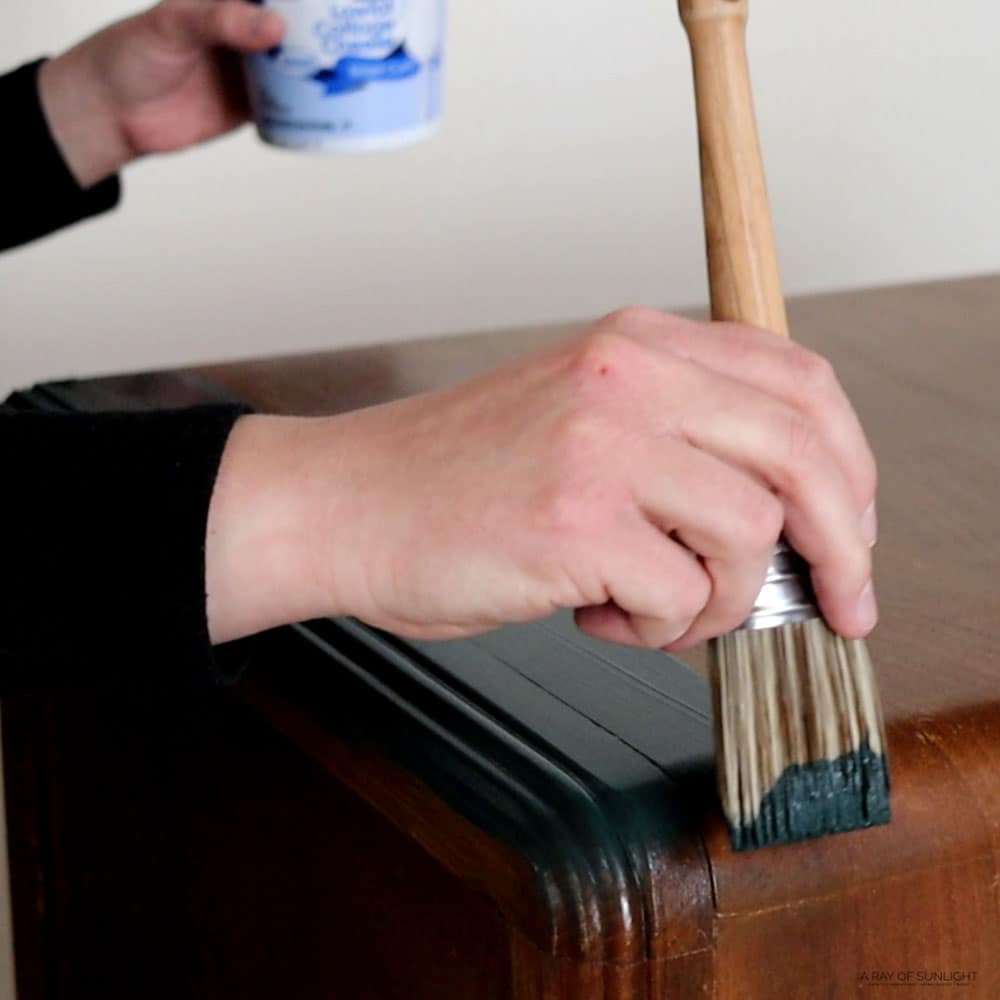
Painting Drawers
You can leave the drawers in, or pull them out and put them on the ground.
I like to do a mixture of both. It’s easier on my back to paint them while they are in the furniture. Then after they are painted, I remove them and set them on the ground.
If you push them back in when the paint is wet, they will get stuck! So be careful of that!
You can use painter’s tape to tape off the sides of the drawers and make sure you don’t get paint where you don’t want it to be. Learn how to prevent overspray when painting furniture here.
I just work carefully with a brush that doesn’t have much paint on it, to try not to get paint on the sides of the drawers. You can paint the sides too if you want…It’s just more to paint.
If I get some paint inside the drawers, I sand it away after the paint is dry.
Painting Dresser
When I’m done painting the first coat, and I’m just waiting for the paint to dry, I put the lid back on my paint, and I wrap my paintbrush in either tin foil or plastic wrap to keep it from drying out.
You can also just wash it out with warm soapy water between coats.
The paint should be dry in about 30 minutes to 1 hour depending on the temperature and humidity where you’re painting. And once it’s dry to the touch, you can start painting the next coat.
The second coat goes on the same as the first coat. This paint covers very very well, another reason I love it.
Before I started to paint again, I put the drawers back in, so I could see what it would look like with the drawers in.
Can you see all of that wood that’s still showing? That’s because I didn’t paint the inside of the dresser at all.

With drawers that are sitting flush with the front of the dresser, there’s always a very good chance that you will see the inside of the dresser a little bit.
So, it’s a good idea to put the drawers back in after they are dry, so you can make sure you painted everything that you need to.
So, I just left them in, and then I painted those areas. And then I pulled out the drawers, finished painting the second coat.. and then set them down on the floor to dry.
If you don’t like the texture in the paint, you can sand the paint when it’s dry, with 220 grit sandpaper.
Just sand it by hand, just enough to remove the texture from the brush. You don’t need to sand it down a lot. Learn more about sandpaper for furniture painting here.
I didn’t sand this dresser between coats because I wanted to show you what kind of look you can get without sanding.
Distress Paint (Optional)
Also, if you want to go for a distressed look, now is a good time! (Or you can wait until after the wax.) Either way!
Use 220 grit sandpaper to sand the paint down on the edges or any details that you want the wood to show. Here are the 6 best distressing furniture techniques… including ways without sanding!
On some pieces, I just rub the sandpaper over the edges of the furniture to make the wood show again. Then I cleaned up the dust before moving on to the next step. I used a vacuum to suck up the dust, and then wiped away any remaining dust.
Topcoat Chalk Paint
The next step is to topcoat the chalk paint. I’ll share how to topcoat with wax in a minute, but, let’s talk about why we topcoat chalk paint first.
Do you have to seal chalk paint?
Yeah… Unfortunately, chalk paint really needs to be sealed.
Chalk paint is very porous, meaning that it’s kind of like a sponge, and will soak up anything that gets on it. So it’s not water resistant at all, and you can’t just wipe off whatever gets on it.
When you touch it with even clean hands, it gets a white residue that looks kind of like dust, and you can’t just wipe it away.
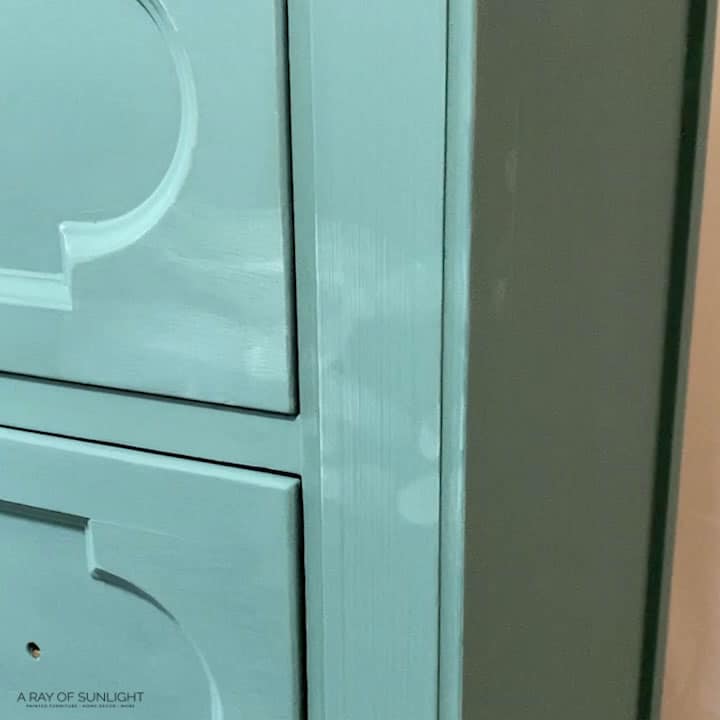
And honestly, chalk paint by itself, especially if there wasn’t any sanding or priming before, is just not very durable. It can scratch and ding pretty easily.
So, we need a topcoat to seal the chalk paint in. Read all about choosing the right topcoats for painting furniture.
The original way of top coating chalk paint is with wax. So that’s why I’m sharing it with you. It’s really easy to use too.
How long to let chalk paint dry before waxing?
It’s best to let the chalk paint dry for at least a couple of hours before you apply wax.
Applying the wax right away can rub off the chalk paint in some areas, so we want to let the chalk paint dry more before we topcoat it.
Unless you want a rubbed, distressed look. Then you can start waxing once the paint feels completely dry.
How to Apply Wax to Chalk Paint
- You can use a stiff-bristled brush to brush the wax on, or you can even use a lint-free cloth like a T-shirt… or even an old sock!
My very favorite wax is this soft wax by the Real Milk Paint Company. It doesn’t stink, and it is so soft and buttery.
You know the saying, wax on.. wax off. And that’s exactly how you apply wax over chalk paint.
- Brush or wipe it on in a small section.
- And then wipe the excess off with a clean cloth.

The more you rub at the wax, the glossier it will get. So if you want less sheen, don’t rub it as much when you’re removing the excess. And if you want it to look glossier, buff it out more.
Then move on to the next section.
Check out my guide on How to Apply Waverly Wax Over Chalk Paint to learn more.
How long does furniture wax take to dry?
It feels dry usually within 30 minutes, but it stays very soft, for what seems like a week or so. It should be completely cured after 30 days.
How many coats of wax on chalk paint?
2-3 thin coats is best, letting it dry for a day or two between coats.
How to Topcoat Chalk Paint with Polyurethane
Top coating with a water-based polyurethane is probably the next most popular method.
Poly and wax each have their pros and cons, and some people prefer one over the other. I’ll share more about the differences in the FAQ section below.
Here’s how to apply polycrylic to painted furniture. If you have a paint sprayer, here’s how to spray polyurethane. (The same method can be used on any color of chalk paint.)
Put New Dresser Hardware On
Then you can put your hardware back on. I changed out the old hardware and put these black knobs on. I think it completely changes the look of the dresser!

Watch the entire process of chalk painting furniture in this video:
Let Chalk Paint and Wax Cure
Now, you just need to let the paint and wax cure. It usually takes about 21-30 days for paint and wax to cure, which means that it can still scratch easily until it has fully dried after 30 days.
So you might want to be extra careful with setting things on the surface, and when you use your furniture until that curing time is over.
After 30 days, the paint and wax will be as hard and durable as it’s going to get!

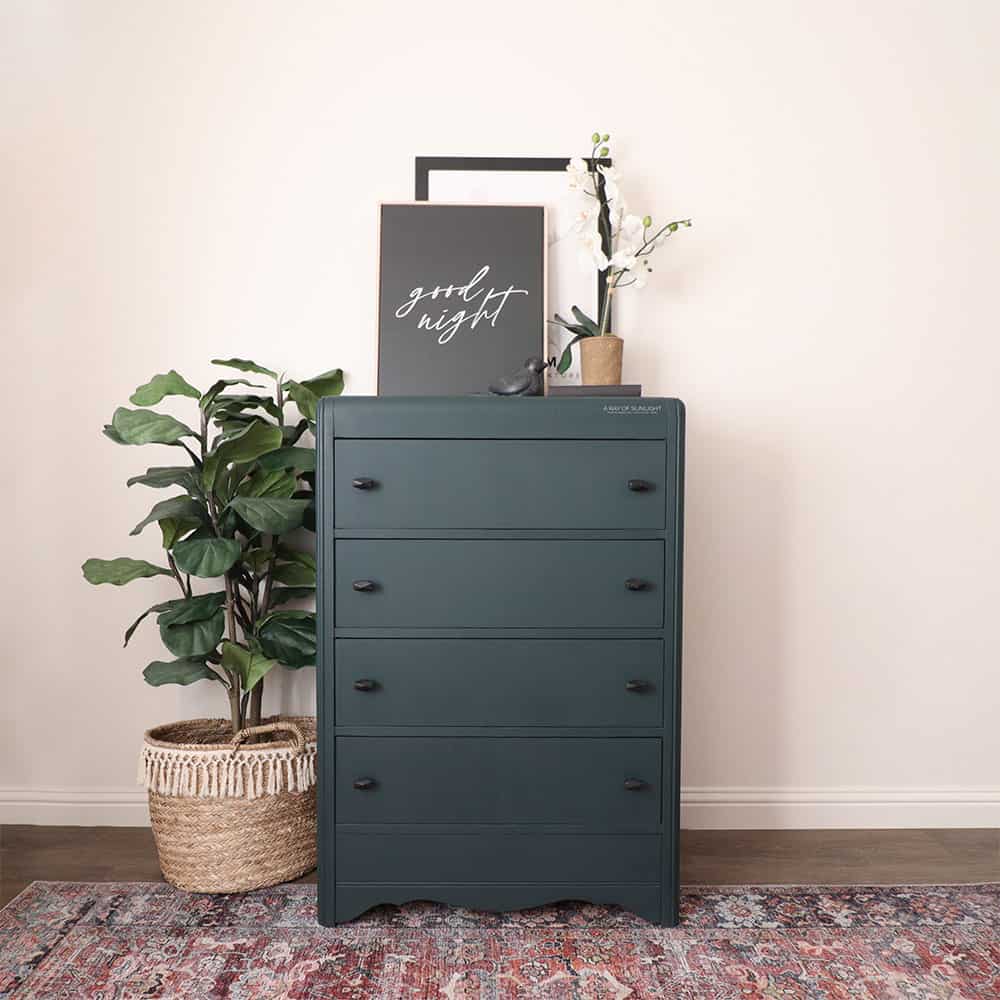
More Before And After Makeovers
Click any of these “before” photos below to view the “after” of that makeover.

Taking Care of Your Chalk Painted Furniture
You can dust it off with a dry cloth, and if you spill anything on it, clean it up immediately. And just like any other furniture, don’t let moisture get to it.
If it gets scuffed up, you can put more wax on it too!
Just like any other furniture, protect it from moisture. So put a coaster under your drinks. 😉
Now you’re ready to chalk paint your furniture! If you want to learn even more about chalk painting furniture, stick around for these Frequently Asked Questions.
Wondering what is chalk paint exactly and why it’s popular? Check out the post to learn more!
Does chalk paint scratch easily?
If you don’t properly prep before painting with chalk paint, then yes, it can scratch easily.

If you haven’t top coated your chalk paint, it will be able to scratch easily too. If you have taken the steps to prepare your surface for paint, it shouldn’t scratch easily, even without a topcoat on it.
Learn more about how to prepare furniture for painting in this post.
How do you prepare a dresser for chalk paint?
For best results with chalk paint:
- Clean with a degreasing cleaner
- Then scuff sand with 220 grit sandpaper, just to dull the finish, but also help sand out scratches.
- Then prime the dresser with a shellac-based primer or clear shellac.
- Paint
- Then topcoat with your choice of topcoat.
Do you have to sand before using chalk paint?
Like I mentioned earlier, for some pieces of furniture, you can get away with not sanding. This piece didn’t really have a slick surface, so I chalk painted it without sanding or priming.
24 hours after I painted, I tested the strength of the chalk paint, and it easily scratched off the sides of the dresser. It did hold onto the drawers really well though.
But, a week after top coating it with wax, the paint didn’t scratch as easily anymore… on any part of the dresser.
It still wasn’t perfect, but if I would have scuff sanded before painting, (or primed) then the paint would have stuck way better! Learn more about the importance of sanding before painting furniture here.
How to Chalk Paint Without Sanding
If you don’t want to have to sand before you chalk paint, but you don’t want to worry about the chalk paint adhering really well, I recommend priming with a shellac-based primer before painting.
It’s as easy as spraying paint! I love this clear shellac in a spray can.
- Shellac blocks bleedthrough, (if you don’t know what bleedthrough is, head over to my post about how to stop stains from coming through paint)
- but it also makes paint, especially chalk paint, stick to the surface SO well!
Just spray the clear shellac onto your furniture, let it dry for an hour, and then paint. I love the clear shellac because it dries clear, so you can’t even tell that it’s there when you paint and distress it.
If you are painting a white chalk paint, BIN shellac-based primer is a white primer that has shellac in it. So it also makes chalk paint stick very very well, but also makes it so you don’t have to paint as many coats of white paint.
Both versions come in a regular paint can as well, so you can brush or roll it on instead of spraying it on.
If you don’t want to use shellac because of its smell, then the white, water-based 123 primer works alright. But it won’t block bleedthrough stains.
Learn more about the best primers for painting furniture here.
How to Repaint Chalk Paint Furniture that was Waxed
Some people say that you can just paint right over the waxed chalk paint. You can try that! Or you can even test it in an inconspicuous area to see if it just scratches right back off after 24 hours.
Wax repels water…, and water-based paint. So the chalk paint will most likely just scratch off super easily.
For best results, remove the wax with mineral spirits and an old rag. After the surface is dry, you can paint it again. And then topcoat it again.
Wax VS. Polyurethane Topcoat
Wax and water-based polyurethane are two of the most popular ways to topcoat chalk paint.
Water-based is better than oil-based, for painted furniture because oil-based polyurethane will tint your color yellow.
| Wax | Water Based Polyurethane |
| Typically wax isn’t as durable as polyurethane is. | Polyurethane is a more durable finish. |
| Technically should be reapplied every 6 months or so. | Doesn’t need to be reapplied. |
| Wax stays kind of soft for at least a few days, but cures in about 30 days. | Polyurethane dries within a couple of hours and is fully cured in 30 days. |
| To repaint, you need to remove the wax first. | To repaint, simply scuff sand before painting again. |
| Looks streaky over dark colors | Looks streaky over dark colors, but you can spray dark colors or use oil based polyurethane to make it not look streaky. |
| Deepens the color of chalk paint | Deepens the color of chalk paint |
| Has to be applied by hand | Can be applied by hand, or sprayed |

How do you get a smooth finish with chalk paint?
There are a couple of things you can do to get a smooth finish with chalk paint.
- Add some water to your chalk paint, so it doesn’t get painted as thick, or with as many brush marks.
- Brush the paint on in the direction of the wood grain. The lines in the wood grain will help hide the brush marks.
- Sand the paint with 220 grit sandpaper once it’s dry. Sand until you see that the brush marks are gone. If you didn’t thin the chalk paint out before painting, you’ll be sanding for a longer time, than if you thinned out the paint before brushing it on. Then paint another coat with the thinned out chalk paint.
- Spray the chalk paint instead of brushing or rolling it on.
How to Spray Chalk Paint
Yes! Spraying chalk paint creates a really nice, brush-free finish on your furniture. You just have to thin it out with water so then the sprayer can spray it.
Check out this post about the FLEXiO 3000 for the tutorial on how to spray chalk paint.
Chalk paint comes in spray cans, too. Read through our chalk spray paint comparison and how to use spray chalk paint tutorial to learn more.
How to Thin Chalk Paint
To thin out your chalk paint, pour the amount of paint you think you’ll use into a separate container. Then add some clean water to it. Mix the paint and water together until it’s fully mixed.
If you are thinning out the chalk paint to brush it on, a 3 part paint to 1 part water should be plenty thin. If you’re thinning out chalk paint to spray it on, adding about 15% water to the amount of paint you are using is usually about right.
But it really depends on your paint sprayer.
How to Distress Furniture with Chalk Paint
My favorite method way to distress chalk paint is to rub 220 grit sandpaper on the edges of the furniture, before top coating.
If you are waxing, you can do it after you wax. But if you’re top coating the chalk paint with poly, you’ll need to distress before you topcoat.
How long should chalk paint dry before applying wax?
Let the chalk paint dry for at least a few hours before applying your wax topcoat. If you can let it dry overnight or for 24 hours, do it.
Let that chalk paint dry and start to cure a little bit before you wax, so the chalk paint doesn’t just rub off when you buff the wax.
How to Make Chalk Paint
Homemade chalk paint is one of my favorite versions of chalk paint. I personally like the calcium carbonate recipe (it’s basically chalk, and you can order it online from Amazon.)
Check out this post to get the homemade chalk paint recipe that I use.
How to Chalk Paint Laminate Furniture
Laminate furniture needs to be primed before you paint it, even with chalk paint. Here are some primers that are really good for painting laminate furniture.
Let it dry according to the directions of the primer you use, and then you can paint chalk paint over it. Here’s a great video where I tested different primers on laminate furniture.
Learn more about how to chalk paint laminate furniture here.
How to Fix Bleed Through With Chalk Paint
If you’ve painted, and probably even top coated your chalk paint, but now you’re seeing bleed through, don’t worry!
If it’s only in one area, you can prime that area to seal the bleedthrough in. Or you can spray primer on the entire piece of furniture so you don’t have any more problems.
Shellac based primers are the best to block bleed through. I use clear shellac, but BIN shellac primer is really good too!
You can also check out how to stop wood knots from bleeding through paint here.
What Are the Pros and Cons of Chalk Paint?
Pros:
- It sticks better than regular paint.
- Chalk paint is beginner friendly, and you might be able to get away without sanding or priming before painting.
- If you like a distressed look, chalk paint sands beautifully!
- You can spray it, brush it or roll it.
- Topcoat it with whatever sheen of topcoat you want!
- It’s waterbased, low or zero VOC, and cleans up very easily.
- It can be layered and blended easily.
- It’s a versatile paint – you can get almost any look with it.
Cons:
- Chalk paint has to be top coated with either wax or polyurethane.
- It isn’t very durable without a topcoat.
- For the most durable finish, you still need to prime/scuff sand.
What happens if you don’t wax chalk paint?
If you don’t seal chalk paint, it is really matte and porous. It will scuff and mark up, even when you lightly touch it with clean hands. The topcoat also helps it to be more durable.
Read through this post to learn more about the truth of using chalk paint for furniture.
Well, that’s it! If you have more questions, let me know how I can help! Good luck with your project!
More Chalk Paint Makeovers
- Dark Green Chalk Painted Dresser Makeover
- Teal Painted Dresser
- How To Paint Fabric With Chalk Paint
- Coffee Table Makeover
- DIY Pink Dresser
Follow us on YouTube to get more tips for painting furniture.
Or share your project with us on our Facebook Group and be part of our community. See you there!
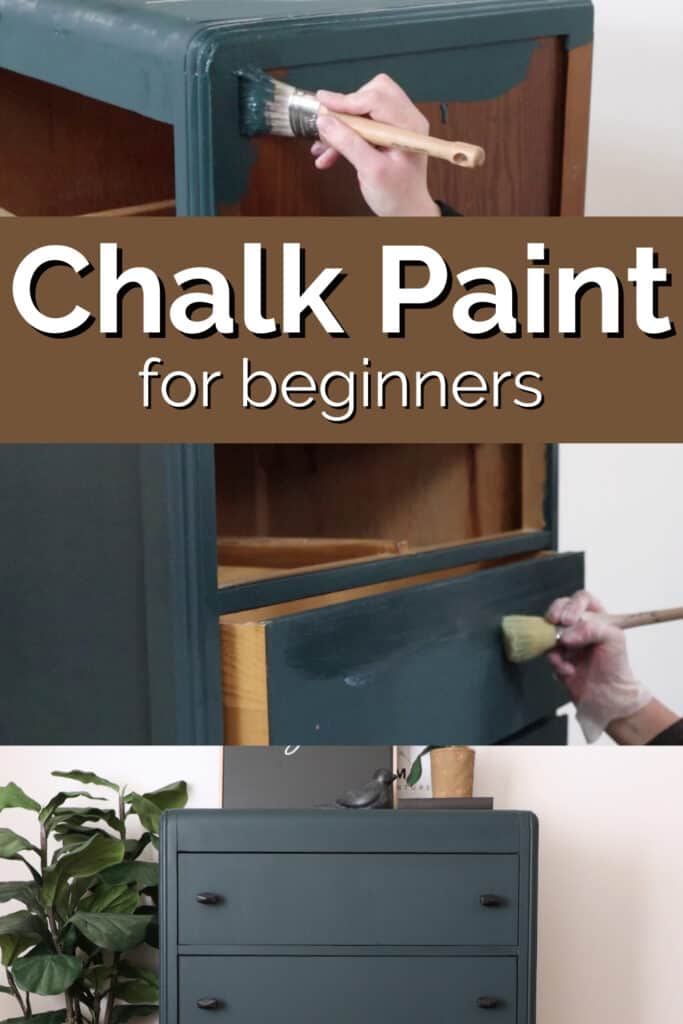





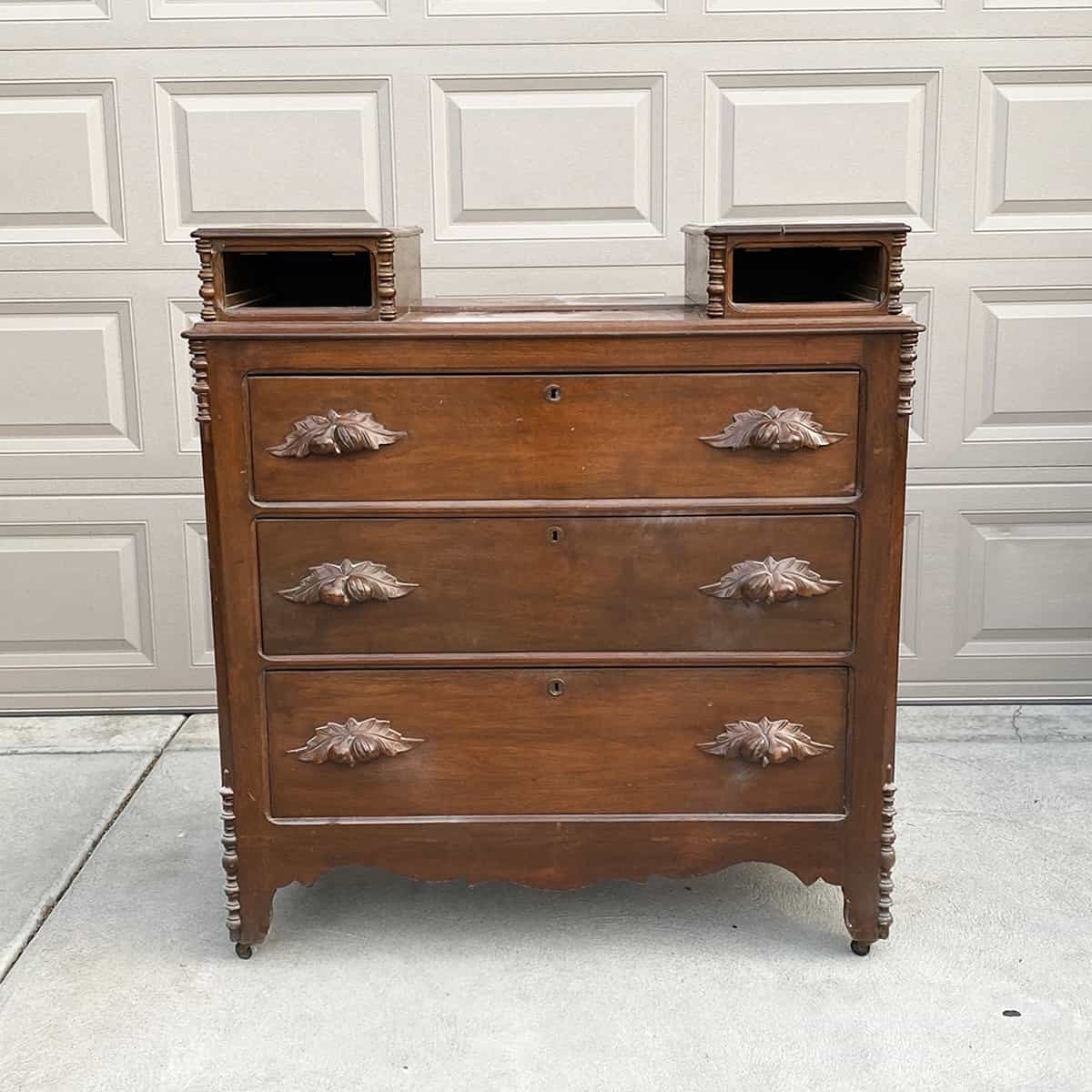

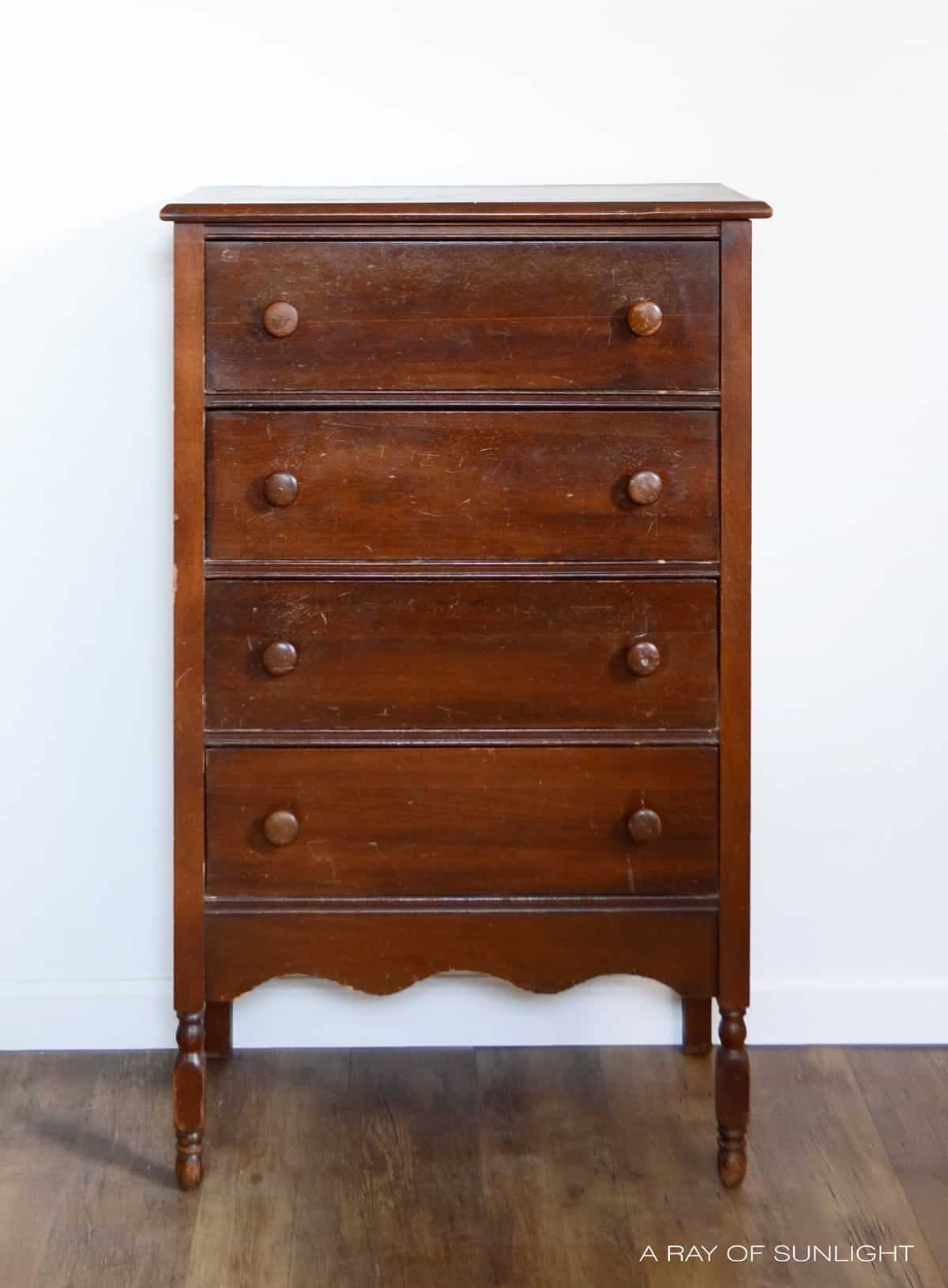
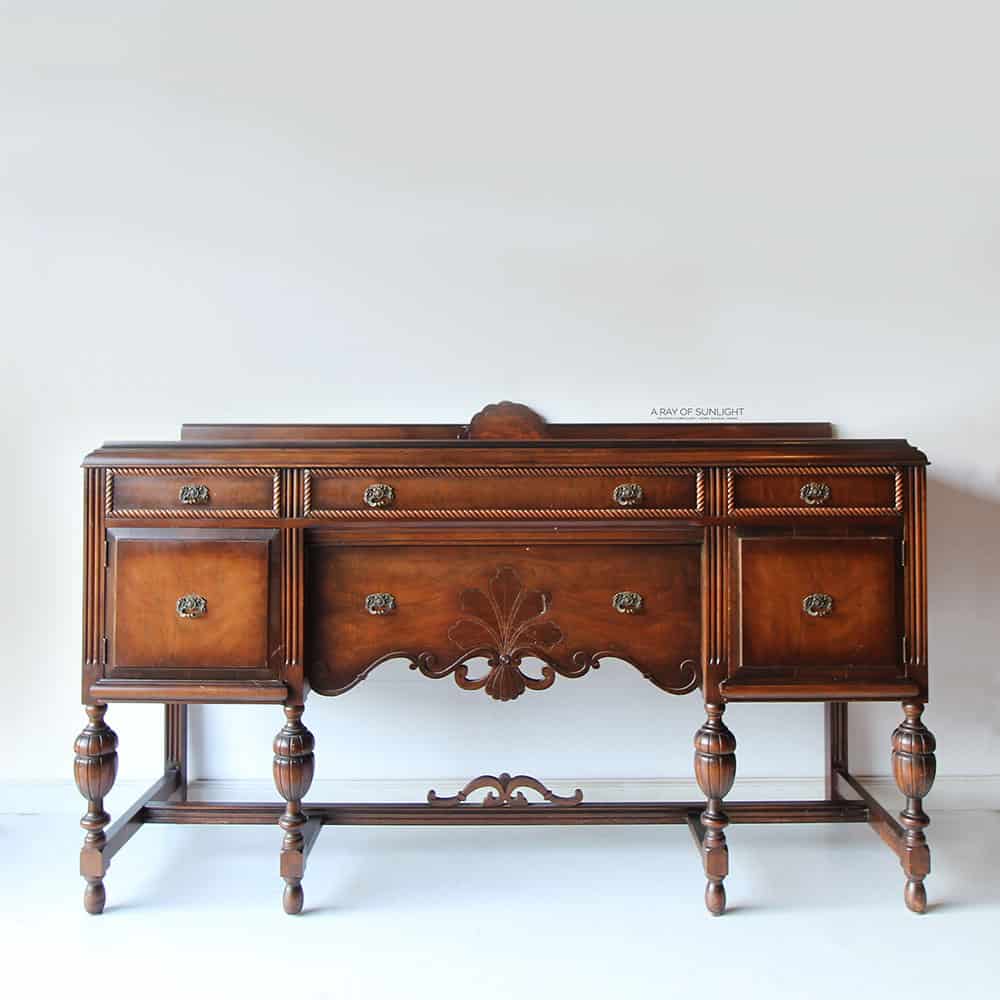
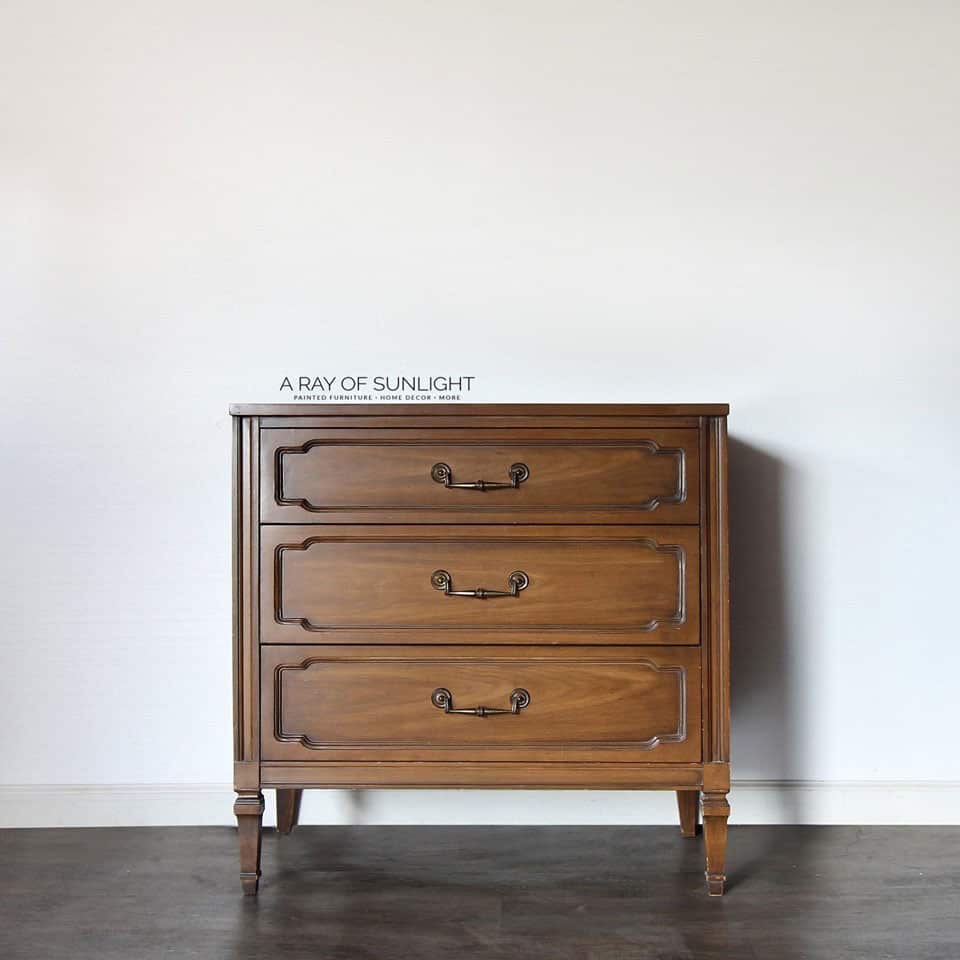







Please share the kind of sander you prefer.
Here are the Best Sanders for Furniture
Unfortunately no. The wax has to come last. But you could put polyurethane on the chalk paint and then put dark wax on the polyurethane. The wax won’t soak in like normal though. But it’s possible to do. I’ve done it.
Hi Natalie! Love your blogs. And after reading this one I started doing my first chalk paint project on my bathroom vanity. Using Forlkart chalk paint in ‘Oatmeal’. However, after the first coat I feel the color is not what I was looking for and is light. Just to try, I mixed little of this one with my black acrylic and it came out to be beautiful greenish grey. Do you think I can use this new version as a second coat. P.S. I am not looking to layer it to distress it.
Thanks
Preet
yes I would paint the new color over the 1st color.